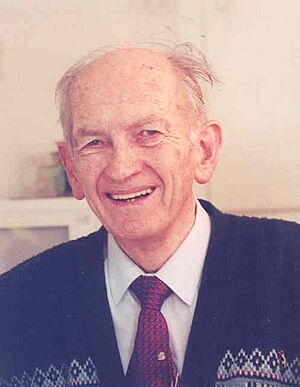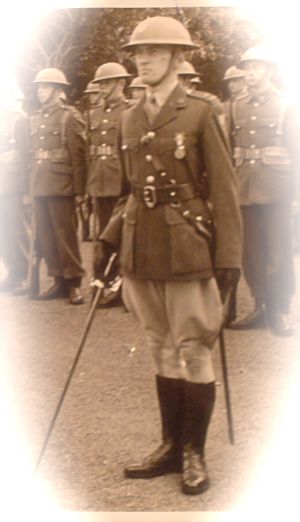Patrick Denis O'Donnell facts for kids
Patrick Denis O'Donnell (born January 9, 1922, died January 1, 2005) was an important Irish historian and writer. He was also a brave soldier and a peacekeeper for the United Nations. He reached the rank of Commandant in the Irish Defence Forces, which is like a Major.
Contents
Early Life and Family
Patrick Denis O'Donnell was born in the Kerries, near Tralee in County Kerry, Ireland. He was the only child of Denis O'Donnell and Hannah Leane. Many people knew him as "Paddy" or "P.D."
His family had a long history, tracing back to the O'Donnells of Tyrconnell. His ancestors settled in Ardfert after Prince Hugh Roe O'Donnell passed through in 1601.
In 1952, he married Stephanie Sarah Teresa Tyndall. They made their home in Fingal, north Dublin. Together, they had three children: Frank (who became Francis Martin O'Donnell), Sally, and Nola.
Education and Training
Patrick O'Donnell went to the Christian Brothers Schools in Tralee. He joined the Irish Army in 1940.
He was a very dedicated student. He completed courses in management and psychology. In 1943, he graduated from the Irish Military College in the Curragh. He also finished his training at the Infantry School with high marks in 1949.
Later, in the 1960s, he studied at the Public Relations Institute of Ireland. He even helped with public relations for the visit of US President John F. Kennedy to Ireland in 1962.
Military Service and Peacekeeping
Patrick O'Donnell served in the Irish Army during what was called "the Emergency." This was the period when Ireland remained neutral during the Second World War.
From 1965 to 1967, he worked as a United Nations Military Observer. He served with the United Nations Truce Supervision Organisation (UNTSO) in Palestine. He was stationed in places like Jerusalem, Tiberias, and Damascus. He received praise for his work there.
After his UN service, he took on important roles. He worked in the Observer Corps, which prepared Ireland for a possible nuclear war. He also worked in military intelligence and helped with border security.
He was a talented artist in his free time. He designed the special symbol for the 5th Infantry Battalion. He rose to the rank of Commandant (Major) before he retired.
He received two important medals for his service. The United Nations Secretary-General gave him the United Nations Medal in 1965. In 1991, the Irish Government awarded him the United Nations Peacekeepers Medal. These awards recognized his efforts for world peace.
Passion for History
Patrick O'Donnell had a deep interest in Irish and Middle Eastern history. He was an active member of the O'Donnell Clan Association. He spent many years researching the O'Donnell family history. He even represented the Irish Defence Forces in these historical matters. He often wrote to O'Donnell family members in Spain and Austria.
He also wrote a series of articles about the history of military barracks in Ireland. He gave talks at the Old Dublin Society.
In 1980, he created the first map of the War of Independence. This map showed important events like ambushes and raids from the early 1920s. He also wrote many articles about American military history. Some of his writings on military technology were even used for teaching at the US Armed Forces Staff College in Virginia.
In December 1994, he gave his collection of military items to the National Museum of Ireland.
He wrote about Irish history outside of military topics too. He explored legends of famous castles like Castlemartin and Ballyheigue. A story he wrote about a ghost at Ballyheigue was later picked up by the American paranormal expert, Hans Holzer.
One of his most famous books was The Irish Faction Fighters of the 19th Century. This book looked at how different groups of people in rural Ireland fought each other. It also showed how these fights were sometimes used to control farmers who were protesting.
Many people saw him as an expert on historical topics. His work was often mentioned by other historians in Ireland and abroad. He wrote over 1,000 articles. He regularly contributed to major Irish newspapers and magazines. These included An Cosantóir, the journal of the Irish Army, and The Irish Sword, a journal about military history.
He was a member of several groups, including writers' associations and the Public Relations Institute of Ireland. He also held the title of Hereditary Lord Steward for Tyrconnell. This role was like a deputy to the Lord High Steward of Ireland. He also inherited an Irish territorial barony called Fingal, which dated back to a grant by King John in 1208. He was also a member of the Knights of St. Columbanus and the lay Third Order of the Dominicans. He also received the Silver Cross of Honour of Jerusalem.
Selected Writings
- Religion in Ireland, in The Marian, Chicago, USA, March 1965.
- Priest with a Palette, in The Marian, Chicago, USA, July–August 1965.
- Mary Gallagher – Violinist, in The Marian, Chicago, USA, July–August, 1966.
- James White – Art Gallery Curator, in The Marian, Chicago, USA, September 1966.
- The Fisher Boy of Galilee, in The Marian, Chicago, USA, March, 1967.
- Holy Week in the Holy Land, in The Marian, Chicago, USA, March, 1969.
- A Visit to Cana, in The Marian, Chicago, USA, July–August, 1970.
- Our Lady of Palestine, in Reality (Redemptorist Publication), September 1983.
- Short Histories of Irish Barracks (including Collins Barracks, Clancy Barracks, Griffith Barracks, McKee Barracks, Keogh Barracks, Aiken Barracks, Mellowes Barracks), in An Cosantoir (Journal of the Irish Defence Forces), 1969–1973.
- Irish-American Heroes in the US Navy, in Sunday Press series, Dublin, 1971.
- Chaplain Courageous, USS Franklin, in Sunday Press series, Dublin, 1971.
- Ghosts and Haunted Castles, in Sunday Press series, 1972.
- The Barracks and Posts of Ireland – 21:Collins Barracks, Dublin, part 3, in An Cosantóir, Dublin, February 1973.
- The Barracks and Posts of Ireland – 22:Royal or Collins Barracks, part 4, the eighteenth century, in An Cosantóir, Dublin, August 1973.
- Pacific Slaughter – Six US Naval Battles, in Sunday Press series, 1973.
- Wolfe Tone's Provost Prison, in The Irish Sword, Military History Society of Ireland, Dublin, 1973.
- The Irish Faction Fighters of the 19th Century", published by Anvil Books, Dublin, 1975.
- Dublin's Collins Barracks over the years, in Hollybough, December 1994.
- Songs of the War Years, in An Cosantoir, the Irish Defence Journal, July/August 1995.
- Dick Dowling, Tuam Emigrant-Texan Hero, in Glimpses of Tuam since the Famine, Old Tuam Society, Tuam, 1997. ISBN: 0-9530250-0-4
- Titanic errors revealed, in CQD Titanic, the official journal of the Ulster Titanic Society, Belfast, Summer 2001.
- The Thermopylae of Lieutenant Dick Dowling, in The Irish Sword, Military History Society of Ireland, Dublin, Summer 2002.
Legacy
Patrick Denis O'Donnell passed away in Beaumont Hospital, Dublin, after a long illness. He was buried in Glasnevin Cemetery. His funeral included military honors, with a special group of pall-bearers from the 5th Infantry Battalion, whose symbol he had designed. The Chief of Staff, Lt. General James Sreenan, and his family and friends were present.
Many newspapers published tributes to him:
- An Appreciation, in The Irish Times, Dublin, January 24, 2005.
- Obituary in Le Figaro newspaper, Paris, March 18, 2005.
- Obituary, Esteemed military historian and writer in The Kerryman newspaper, Tralee, January 13, 2005.
- Obituary, Army officer was military expert, in Kerry Eye newspaper, Tralee, January 27, 2005.
- Obituary P.D. O'Donnell, RIP in O'Domhnaill Abu, O'Donnell Clan Newsletter no. 33, Donegal, Spring 2005 [1].





